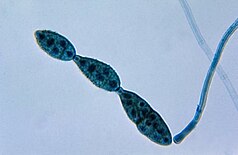Our website is made possible by displaying online advertisements to our visitors.
Please consider supporting us by disabling your ad blocker.
Pleosporales
 | ||||||||||||||||||
| Biologia klasado | ||||||||||||||||||
| ||||||||||||||||||
Aliaj Vikimediaj projektoj
| ||||||||||||||||||
Pleosporales estas la plej granda ordo en la funga klaso Dothideomycetes. Laŭ takso en 2008, ĝi havas 23 familiojn, 332 genrojn, kaj pli ol 4700 speciojn.[1] La plejparto de la specioj estas sapruloj sur putra planta materialo en sensalakvaj,[2] maraj,[3] aŭ teraj medioj, dum pluraj specioj asociiĝas kun vivantaj plantoj kiel parazitoj, epifitoj aŭ endofitoj.[4] La plej bone studitaj specioj kaŭzas malsanojn de gravaj kultivoplantoj, ekz. Cochliobolus heterostrophus, kiu kaŭzas sudan maizfolian ŝimon, Phaeosphaeria nodorum, kiu kaŭzas gluman makulon ĉe tritiko, kaj Leptosphaeria maculans, kiu kaŭzas tigan ŝankron ĉe brasikoj). Iuj specioj de Pleosporales vivas sur sterko,[5] kaj mulmultaj kiel likenoj [6] aŭ rokaj fungoj.[7]
- ↑ Citaĵa eraro Malvalida etikedo
<ref>; neniu teksto estis provizita por ref-oj nomatajKirk 2008; $2 - ↑ Shearer C.A., Raja H.A., Miller A.N., Nelson P, Tanaka K, Hirayama K, Marvanová L, Hyde K.D., Zhang Z. 2009. The molecular phylogeny of freshwater Dothideomycetes. Studies in Mycology 64: 145–153.[1] Arkivigite je 2011-07-28 per la retarkivo Wayback Machine
- ↑ Suetrong S, Schoch C.L., Spatafora J.W., Kohlmeyer J, Volkmann-Kohlmeyer B, Sakayaroj J, Phongpaichit S, Tanaka K, Hirayama K, Jones E.B.G. 2009. Molecular systematics of the marine Dothideomycetes. Studies in Mycology 64: 155–173.[2] Arkivigite je 2011-07-28 per la retarkivo Wayback Machine
- ↑ Citaĵa eraro Malvalida etikedo
<ref>; neniu teksto estis provizita por ref-oj nomatajZhang; $2 - ↑ Kruys Å, Eriksson OE, Wedin M. 2006. Phylogenetic relationships of coprophilous Pleosporales (Dothideomycetes, Ascomycota), and the classification of some bitunicate taxa of unknown position. Mycological Research 110:527–536
- ↑ Nelsen MP, Lücking R, Grube M, Mbatchou JS, Muggia L, Rivas Plata E, Lumbsch HT. 2009. Unravelling the phylogenetic relationships of lichenised fungi in Dothideomyceta. Studies in Mycology 64: 135–144.[3] Arkivigite je 2011-07-28 per la retarkivo Wayback Machine
- ↑ Ruibal C, Gueidan C, Selbmann L, Gorbushina AA, Crous PW, Groenewald JZ, Muggia L, Grube M, Isola D, Schoch CL, Staley JT, Lutzoni F, Hoog GS De. 2009. Phylogeny of rock-inhabiting fungi related to Dothideomycetes. Studies in Mycology 64: 123–133.[4] Arkivigite je 2011-07-28 per la retarkivo Wayback Machine
Previous Page Next Page





